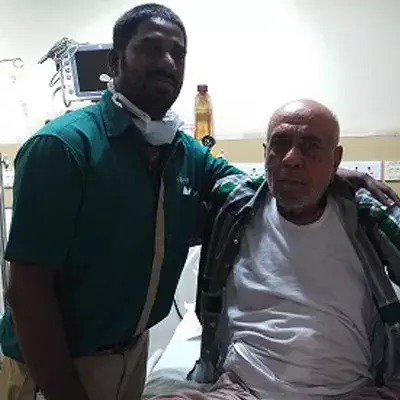Hernia Surgery in Chembur, Mumbai
A hernia is a condition when an organ pushes through an opening in the tissue or muscle that keeps it in place. For instance, the intestines breaking through a weakened part of the abdominal wall might call for hernia treatment.
Hernias are commonly seen in the abdominal region between the chest and the hips. However, you might also get hernias in the groin and upper thigh areas. Hernias are usually not life-threatening, and you can get proper hernia treatment in Mumbai to cure them effectively.

What Are The Common Types Of Hernias?
Hernias are mainly of three types, and they are:
- Inguinal Hernia:
Inguinal hernias occur when the intestines push through a tear in the lower wall of the abdomen. It is more common occurs in men.
- Hiatal Hernia:
When the top portion of the stomach protrudes up through the diaphragm into the chest cavity, a hiatal hernia occurs. It is a common condition in people over fifty years old.
- Umbilical Hernia:
An umbilical hernia is common in babies and children. In this case, the intestines bulge through the abdominal wall near the belly button.
What Are the Symptoms of Hernia?
A lump or bulge in the affected area is the most common sign of hernia. For instance, a lump on any side of the pubic bone, where the thigh and groin meet, might be the sign of an inguinal hernia.
You need to see a doctor if you notice:
- Increasing pain at the site of the lump
- Swelling or bulge formation in the groin or scrotum
- Pain at the time of lifting
- A constant dull ache at the site
- With time, an increase in the bulge’s size
- Signs of bowel obstruction
- A constant sense of feeling full
Hiatal hernias don’t show such bulges outside the body. So, see in case of frequent regurgitation and heartburn.
If you are in Mumbai, consult hernia specialists in Chembur.
Underlying Causes of Hernia
The most common cause of hernias is muscle weakness. Some common instances are:
- Aging
- Smoking
- Damages from a surgery or injury
- Congenital conditions occurring in the womb
- COPD (Chronic Obstructive Pulmonary Disorder)
- Obesity or being overweight
- Strenuous exercising
- Multiple pregnancies
- Chronic constipation
- Fluid accumulation in the abdomen
When Should I See a Doctor for Hernia?
Dear Mumbaikar, you need to see a hernia specialist in Mumbai as soon as possible if:
- You have a noticeable protrusion or bulge, along with chills, fever, or vomiting.
- You are constantly unable to have a normal bowel movement.
Some hernias are extremely severe and need immediate medical attention. If you are looking for ‘hernia hospital near me,’
You can request an appointment at Apollo Spectra Hospitals, Chembur, Mumbai.
Call 1860 500 2244 to book an appointment.
What Are the Possible Complications for Hernia?
You might need to visit a hernia hospital in Mumbai if the following complications arise out of hernia:
- Infection from surgical procedures or a strangulated hernia leading to tissue death.
- A side-effect of any abdominal surgery, and even a hernia repair surgery.
- Bladder injury and mesh that is left to repair the weakened muscle area of the bladder.
- Intestine resection complications where the surgeons need to remove a part of the intestine.
What Are the Treatment Options for Hernia?
The best way to treat a hernia is through surgical repairs. However, hernia doctors in Mumbai decide whether or not you need surgery based on the size of the hernia and the severity of the symptoms. Your doctors might want to monitor the hernia for some time to check for possible complications.
In some cases, prescription and over-the-counter medications can improve your symptoms. Wearing supportive undergarments suggested by doctors can also help in easing the symptoms.
It is important to search for a ‘hernia specialist near me’ to seek treatment.
You can request an appointment at Apollo Spectra Hospitals in Chembur, Mumbai.
Call 1860 500 1066 to book an appointment.
Conclusion
Hernias are serious disorders that need prompt medical attention from a hernia specialist near you. Your doctor assesses your condition and suggests the proper way of treatment to remedy your condition. Timely treatment can effectively cure all types of hernias.
Hernias never go away on their own. In some cases, medications can treat small hernias, but the best course of treatment for severe conditions is surgery.
If you feel a lump in the pubic bone or the abdominal region, lie down to see if the lump disappears. If it does, it might be a hernia.
Hernia repair is a common surgery, but it is a major one with risk factors and potential complications. Talk to your doctor to know more.
Symptoms
Our Patient Speaks
My son was treated at the Apollo Spectra Hospital, and I have had a very good experience here. The doctors at the hospital were very helpful. The nursing staff at the hospital took very good care of my son and proved to be very helpful. All the services at the hospital were very well organised and taken care of, including the billing service, which was done very fast, as well as the security at the hospital premises. The hospital premises were also very clean and sanitised.
Dad Mohamed
General and Laproscopic Surgery
Hernia
A Mumbai-based patient was suffering from Hernia. He had consulted a lot of doctors and went to a few hospitals but wasn't satisfied. He then decided to get treated at Apollo Spectra and was happy with the treatment he received, services offered and more. Listen to his experience as he narrates his account with Apollo Spectra.
Superlative Treatment for Hernia at Apollo Spectra
Hernia
Our Top Specialities
NOTICE BOARD
CONTACT US
CONTACT US
 Book Appointment
Book Appointment




.svg)
.svg)
.svg)
.svg)








